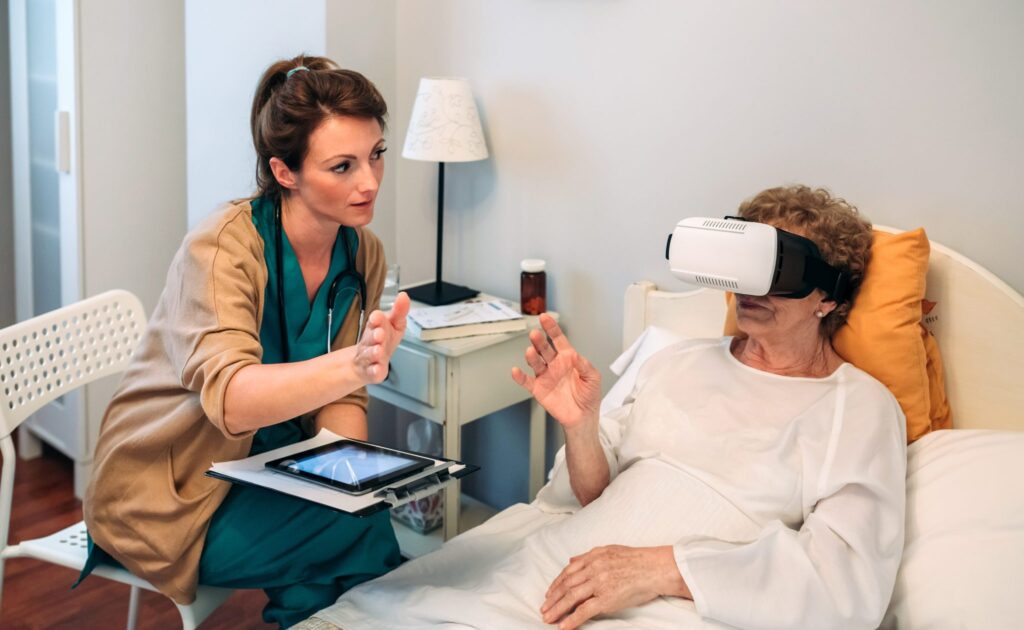
Have you ever imagined escaping intense pain just by slipping on a headset? No, it’s not science fiction–it’s the power of Virtual Reality (VR) in pain management. It is a groundbreaking approach that is easing discomfort and transforming lives. You are currently living in a world where pain relief is not just about popping pills or enduring discomfort. Virtual reality has the potential to alleviate pain and provide a non-pharmacological approach to managing discomfort.
In this comprehensive article, we’ll explore the incredible benefits of virtual reality in pain management. Additionally, we’ll discuss the science behind VR’s effectiveness in pain management, the steps of incorporating virtual reality into your pain management practices, and the challenges and limitations that still exist in VR as a pain-relieving method.
What is Virtual Reality (VR)?
Before we get into the revolutionary role of virtual reality in pain management, let’s clarify what VR is. Virtual reality is the technology that immerses users in a digitally created environment that feels incredibly real. It’s not just limited to seeing; it’s experiencing a new world without leaving your spot. Whether you desire to climb Everest or explore the depths of the ocean, VR is ready to break the bounds of reality.


Understanding the Science Behind Virtual Reality’s Effectiveness in Pain Management
To comprehend how virtual reality effectively manages pain, we must first understand the underlying science behind pain. When a person experiences pain, their brain receives signals from the affected area. The brain translates these signals into the sensation of discomfort. VR works by diverting the brain’s attention away from the pain signals, effectively reducing pain perception.
By immersing and diverting patients into a virtual environment, VR provides a multi-sensory experience. This experience captivates their attention and creates an alternative focus for the brain. This distraction technique has been proven to significantly reduce pain intensity and discomfort for patients.
Furthermore, VR can induce a state of relaxation and calmness. By immersing patients in serene and soothing environments, such as a peaceful beach or a tranquil forest, VR triggers endorphins release, further promoting relaxation. This combination of distraction and relaxation makes VR effective in managing acute and chronic pain. It also provides a therapeutic escape from postoperative pain and even anxiety during medical procedures.
Also Read: What are Happy Hormones And How To Hack Them? A Comprehensive Guide
The Benefits of Virtual Reality in Pain Management
Virtual reality has following benefits in pain management:
Non-Invasive Pain Relief
Traditional methods of pain management often involve invasive procedures or the use of pharmaceuticals. These methods usually have side effects. On the other hand, VR offers a non-invasive alternative method that does not rely on drugs or medical procedures, which makes it a safer option for many patients. It is particularly advantageous for people who are unable to tolerate medications or prefer to minimize their use of pharmaceuticals.
Drug-Free Solution
In this modern era, there are concerns about opioid addiction and overuse. Opioid, while effective in managing pain, carries the risk of addiction and other adverse side effects. VR has been proven to be a drug-free solution for pain relief. VR therapy provides a drug-free alternative that reduces the need for pharmaceutical intervention, minimizing the risk of dependence and side effects.
Customizable Experience
One of the most compelling aspects of VR in pain management is the ability to tailor experience to individual preferences and needs. You can choose from various immersive environments, from serene landscapes to thrilling adventures. Virtual reality allows you to find the experience that best distracts them from the pain.
Enhanced Engagement and Compliance
Traditional pain management techniques often require patients to engage in repetitive exercises or activities that can be tedious and boring. Virtual reality offers more engaging and enjoyable experiences. It increases patient compliance and adherence to treatment plans.
Improved Psychological Well-being
Chronic pain has a significant impact on mental health, along with taking a physical toll. VR provides a welcome escape from the daily struggles of chronic pain. It offers a respite for the mind and promotes relaxation and well-being.
Cost-Effective Solution
The initial investment in VR technology may seem significant. However, the long-term cost-effectiveness of virtual reality in pain management cannot be overstated. Since VR reduces the need for expensive medications and invasive procedures, it can ultimately become cost-effective for patients and healthcare providers.
Improved Patient Outcomes
Virtual reality benefits the patients and has several advantages for healthcare providers. One such benefit is improved patient outcomes. By incorporating VR into your pain management strategies, your healthcare provider can offer a more comprehensive and holistic approach to treatment. Combining traditional pain interventions and VR allows for a personalized, patient-oriented care plan. It results in better pain relief and overall satisfaction.
Accessible Anywhere, Anytime
While traditional pain management techniques may require colic visits or specialized equipment, VR is accessible virtually anywhere, anytime. You can easily incorporate VR into your pain management routine at home or in healthcare. It makes VR a convenient and versatile tool.
How Does VR Work in Pain Management?
VR works through the following steps:
Step 1: Assessment
VR, as a pain-relieving technique, begins with a thorough assessment by a healthcare professional. He determines if VR therapy is suitable for your pain management needs.
Step 2: Customization
A customized VR plan is crafted based on your previous assessment, preferences, and therapeutic goals. Whether it’s a peaceful landscape, engaging puzzles, or interactive games, the content of VR therapy is tailored to provide the most effective distraction and relaxation.
Step 3: Immersion
In this step, you’re equipped with a VR headset and controllers, and the real magic happens. You’re transported into a virtual world that captivates your senses. It helps to shift your focus away from the pain.
Step 4: Integration
VR pain management therapy is often part of a broader pain management plan, complementing physical therapy, medication, or other treatments that tend to provide a holistic approach to pain relief.
How to Incorporate Virtual Reality into Your Pain Management Routine?
You can follow these steps to incorporate virtual reality into your pain management routine:
Step 1: Consult with a Healthcare Professional
Before incorporating VR therapy into your pain management routine, it’s essential to consult with a healthcare professional. They can help determine if VR is a suitable option for your specific needs. They will also guide you on integrating VR into your treatment plan.
Step 2: Choose the Right VR System
There are various virtual reality systems available in the market. Each system offers different features and experiences. Take the time to research and choose a system that aligns with your preferences and budget.
Step 3: Select Immersive Environments
Once you have your VR system, explore the various immersive environments available. Experiment with different settings to find what works best for you. Choose it according to the best distraction and pain relief methods.


Step 4: Incorporate VR into Your Routine
After selecting the best VR method for you, integrate VR into your pain management routine. You can use it as a complementary tool alongside other treatments and therapies. Consistency is key to getting the maximum benefits.
Step 5: Monitor Your Progress
Keep track of your pain management progress while using virtual reality as a tool. If you find any changes in pain levels, mood, or overall well-being, communicate this information with your healthcare provider.
Step 6: Adjust it as Needed
Adjusting and adapting your approach and requirements is essential with any pain management strategy. If certain environments or experiences are not providing the desired relief, don’t hesitate to explore other options or seek guidance from your healthcare provider.
Challenges and Limitations of Virtual Reality in Pain Management
Although virtual reality offers excellent promise in pain management, certain challenges and limitations exist. A few of the challenges and limitations include:
- Initial Cost – Implementing VR systems can be a barrier, particularly for smaller healthcare facilities. Initial investment in hardware and software and the ongoing maintenance and updates can also be prohibitive.
- Training – Training your healthcare providers to effectively utilize VR in pain management can be challenging as it requires time and resources.
- Potential Side Effects – Side effects like motion sickness or disorientation can limit VR’s effectiveness in pain management practices.
- Not Suitable for All Pains – VR may not be suitable for all forms of pain, such as severe acute injuries or certain neuropathic conditions.
Healthcare providers must carefully assess each patient’s needs and pain profile. It’ll help determine VR’s appropriateness in their pain management plan.
Concluding Thoughts
Virtual reality VR has emerged as a game-changer in pain management strategies. It offers a non-pharmacological and immersive approach to alleviate your pain. The science behind VR’s effectiveness is coupled with its numerous benefits for patients and healthcare providers. VR has revolutionized pain management practices. By incorporating virtual reality technology into pain management practices, healthcare providers can reduce reliance on opioids, enhance patient outcomes, and improve patient satisfaction.
While challenges and limitations exist, ongoing research and technological advancements pave the way for a future where VR becomes an integral part of pain management protocols. Are you ready to take control of your pain management journey and experience the incredible benefits of VR? Consult with your healthcare provider today and embark on a new path toward relief and well-being!
FAQs: Virtual Reality in Pain Management
Q.1: How can I incorporate Virtual Reality into my pain management routine?
To incorporate VR into your pain management routine, consult with a healthcare professional to determine if VR is appropriate for your specific needs. Once cleared, choose a VR system that aligns with your preferences and budget. Experiment with different immersive environments to find what works best for you. Incorporate VR into your routine, alongside other treatments and therapies, and monitor your progress. Adjust your approach as needed, and always communicate any changes in your pain levels or overall well-being with your healthcare provider.
Q.2: How do healthcare professionals assess a patient’s suitability for VR pain management therapy?
Healthcare professionals assess a patient’s suitability for VR therapy by considering their medical history, pain type and intensity, psychological condition, and susceptibility to motion sickness or VR-induced side effects. They also evaluate the patient’s cognitive and physical ability to interact with a VR environment. This assessment ensures that the VR therapy aligns with the patient’s pain management needs and overall treatment goals.
Q.3: Can VR therapy be personalized for individual pain management needs, and if so, how?
Yes, VR therapy can be personalized for individual needs. This customization involves selecting and modifying virtual environments, activities, and simulations based on the patient’s preferences, pain type, and therapy goals. Developers can create scenarios that target specific types of pain or anxiety. Additionally, the intensity and duration of VR sessions can be adjusted to match the patient’s endurance and treatment plan, making the experience more effective and comfortable.
Q.4: How do healthcare providers measure the effectiveness of VR in managing a patient’s pain?
Healthcare providers measure the effectiveness of VR in pain management through patient-reported outcomes, such as scales for pain intensity, quality of life assessments, and psychological well-being surveys. They may also use objective measures like changes in medication usage, physiological indicators (e.g., heart rate, blood pressure), and the patient’s engagement and compliance with the VR therapy. Regular assessments help tailor the therapy to the patient’s changing needs and evaluate the long-term benefits of VR in pain management.
Q.5: What are the current limitations in the technology or research regarding VR for pain management, and how might these be addressed in the future?
Current limitations in VR technology for pain management include high costs, lack of standardized protocols, limited access to equipment, and the need for more comprehensive research to understand its effectiveness across different types of pain and patient demographics. Additionally, some patients may experience side effects like dizziness or nausea. Future advancements may address these issues through the development of more affordable and user-friendly VR systems, broader implementation of clinical trials, and the creation of guidelines for VR applications in pain management. As technology advances and becomes more accessible, these limitations are likely to diminish, making VR a more integrated part of pain management strategies.

